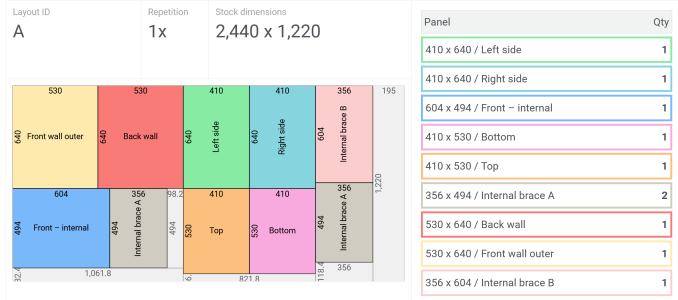Hi All,
I'm a complete novice to woodworking, but I'd like to approach my first project with as much accuracy as possible. I’ll be building 8 sealed subwoofer boxes (see attached cut sheet) and I have a few questions about best practices.
The saw I plan to use is the Festool TS 60.
Would the following workflow be considered good practice (please suggest improvements or more efficient way about it)?
Once I’ve completed the first box and confirmed I can hit the accuracy I’m aiming for, I plan to rework the cut sheets for the remaining 7 boxes to streamline the process and take better advantage of repetitive cuts using either the parallel guide or rail square system.
Thanks in advance for your advice!
EDIT: I have two more projects coming after this one. One would be 2.8m long AV cabinet, so FS3000 will be probably handy for that as well.

I'm a complete novice to woodworking, but I'd like to approach my first project with as much accuracy as possible. I’ll be building 8 sealed subwoofer boxes (see attached cut sheet) and I have a few questions about best practices.
The saw I plan to use is the Festool TS 60.
Would the following workflow be considered good practice (please suggest improvements or more efficient way about it)?
- Rip the factory edge off the plywood sheet (removing 2-4 mm including kerf) to create a clean reference edge. I’d use a full-length FS 3000 rail for this.
- Using this freshly cut edge, a square rail setup (Benchdogs or TSO style), and a shorter rail like the FS 1400, trim the adjacent factory edge (removing another 2–4 mm including kerf) to create two known reference edges that are square to each other.
- Using the long reference edge from step 1 and a parallel guide system (Benchdogs or TSO style), rip the board at approximately 645 mm, using the TS 60’s splinter guard to protect the off-cut edge.
- Proceed to crosscuts. Would I be better off switching to a rail square (e.g. FS-WA or TSO), or continuing to use the parallel guide system? I’ve read that crosscuts using a square may be faster and easier, but I’m not sure if they’re as accurate.
Once I’ve completed the first box and confirmed I can hit the accuracy I’m aiming for, I plan to rework the cut sheets for the remaining 7 boxes to streamline the process and take better advantage of repetitive cuts using either the parallel guide or rail square system.
Thanks in advance for your advice!
EDIT: I have two more projects coming after this one. One would be 2.8m long AV cabinet, so FS3000 will be probably handy for that as well.

Last edited:



